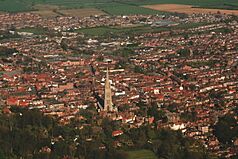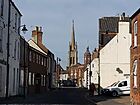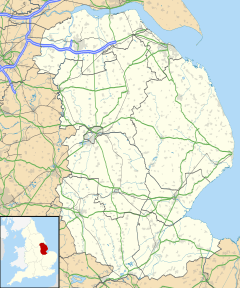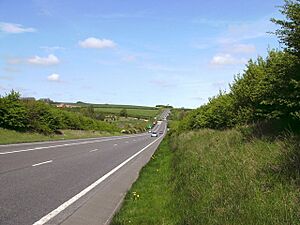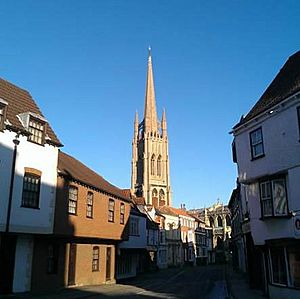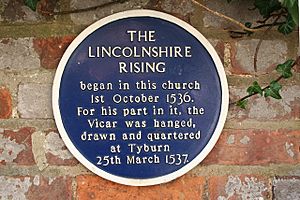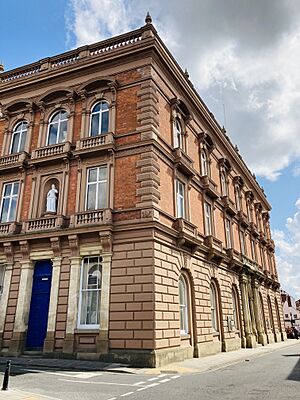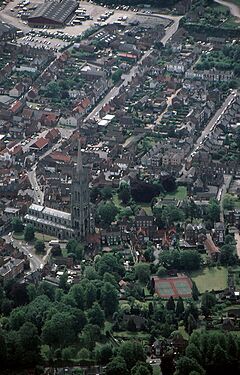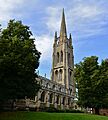Louth, Lincolnshire facts for kids
Quick facts for kids Louth |
|
|---|---|
|
Clockwise from top: Aerial view of Louth, Old Station Building, Queen Street, Parish Church and Town Hall |
|
| Population | 17,382 (2021 Census) |
| OS grid reference | TF326874 |
| • London | 130 mi (210 km) S |
| Civil parish |
|
| District | |
| Shire county | |
| Region | |
| Country | England |
| Sovereign state | United Kingdom |
| Post town | LOUTH |
| Postcode district | LN11 |
| Dialling code | 01507 |
| Police | Lincolnshire |
| Fire | Lincolnshire |
| Ambulance | East Midlands |
| EU Parliament | East Midlands |
| UK Parliament |
|
Louth (![]() i/laʊθ/) is a lively market town and civil parish in the East Lindsey area of Lincolnshire, England. It's an important town for the many villages and farms around eastern Lincolnshire. People visit Louth for its famous St James' Church, the beautiful Hubbard's Hills, its busy market, and lots of unique shops. It even has Lincolnshire's last remaining cattle market!
i/laʊθ/) is a lively market town and civil parish in the East Lindsey area of Lincolnshire, England. It's an important town for the many villages and farms around eastern Lincolnshire. People visit Louth for its famous St James' Church, the beautiful Hubbard's Hills, its busy market, and lots of unique shops. It even has Lincolnshire's last remaining cattle market!
Contents
- Exploring Louth's Geography
- Louth Through Time: A Brief History
- Getting Around Louth: Transport
- St James' Church: A Landmark of Louth
- Interesting Places to See in Louth
- Shopping and Business in Louth
- Community and Fun in Louth
- Sports and Activities
- Local News and Media
- Learning in Louth: Education
- Louth's Twin Town
- People from Louth
- Images for kids
- See also
Exploring Louth's Geography
Louth is located at the edge of the Lincolnshire Wolds, where these hills meet the flat Lincolnshire Marsh. The town grew up where an old path along the Wolds, called Barton Street, crossed the River Lud. To the east of Louth, there's a deep valley carved into the Wolds called Hubbard's Hills. This valley was formed by melting ice during the last glacial period. The River Lud flows through this valley before reaching the town.
Nearby villages include Legbourne to the southeast and Keddington to the northeast. To the northwest is South Elkington, and Hallington is to the southwest. Other towns close to Louth are Wragby, Market Rasen, Horncastle, Mablethorpe, Grimsby, and Alford.
The Greenwich Meridian, an imaginary line that divides the Earth, passes through Louth. There are plaques on Eastgate street to mark it, though the exact spot is slightly different. A new road called the A16 Louth Bypass was built in 1991. It cost £6.6 million and is three miles (5 km) long. The old road through the town is now called the B1520.
Louth Through Time: A Brief History
Tools found around Louth show people lived here between 424,000 and 191,000 years ago. This was during the Paleolithic (Old Stone Age) era. Later, in the Bronze Age, an arrowhead was found near Monks' Dyke Tennyson College.
St Helen's Spring, a natural water source, is thought to be a very old site. People might have worshipped a water goddess there long ago, even before Christianity arrived.
An Anglo-Saxon burial ground, found northwest of Louth, dates back to the 5th and 6th centuries. It's one of England's largest Anglo-Saxon cremation cemeteries, with about 1200 burials.
Louth is mentioned in the 1086 Domesday Book. This old record shows it was a town with 124 households.
Louth Park Abbey was a monastery founded in 1139. It was built by the Bishop of Lincoln and was connected to Fountains Abbey in Yorkshire. After it was closed down in 1536, it fell into ruin. Today, you can only see its remains on private land between Louth and Keddington.
In 1643, during the English Civil War, a local man named Sir Charles Bolles gathered soldiers for the King's side. There was fighting in and around Louth. Some soldiers were killed in a skirmish.
Louth experienced a terrible flood on May 29, 1920. It caused 23 deaths. One woman survived by climbing a chimney! Four stone plaques in town show how high the water reached. Smaller floods also happened in 1968 and 2007.
Margaret Wintringham became Louth's Member of Parliament (MP) in 1921. She was the first female MP for the Liberals and only the third woman MP in Britain. Later, Jeffrey Archer was Louth's MP from 1969 to 1974.
The Story of St Herefrith
St Herefrith is Louth's "forgotten saint." His special day is February 27. He was a bishop who died around 873, possibly killed by the Danes. An old text from the 11th century says he was a Bishop of Lincoln, but this might mean the area of Lindsey, which is what Lincolnshire was called back then.
After his death, a special place to honor him, called a shrine, was set up in Louth. Later, a bishop from Winchester sent monks to Louth to take Herefrith's remains for a new abbey. They tricked the people of Louth and took the saint's body.
A church dedicated to St Herefrith existed in Louth from the 13th to 15th centuries. An ivory comb, believed to be one of his relics, was kept at St. James Church, Louth in 1486.
Getting Around Louth: Transport
Louth has regular bus services that connect it to nearby towns like Grimsby, Skegness, Mablethorpe, and Lincoln. Stagecoach is one of the main bus companies. However, there are no late-night buses; the last one leaves Louth at 7:30 pm.
The closest active train stations are now in Market Rasen, Grimsby Town, and Skegness.
Louth used to have its own train station, Louth railway station. It was an important stop on the East Lincolnshire Railway from 1848. It also had a large goods yard for malt kilns. The station closed to passengers in 1970. The railway line to Grimsby was used for freight until 1980, then it was removed. The old station building is now private homes.
There are plans to bring trains back to Louth! The Lincolnshire Wolds Railway wants to extend its line to the north of Louth. This would give Louth a train connection again after almost 50 years.
The Louth Canal was built between 1765 and 1770 to link Louth to the sea. It stopped being used in 1924.
St James' Church: A Landmark of Louth
The town was the starting point of the Lincolnshire Rising. This event began on October 1, 1536, right in St James Church. The church's priest gave a powerful sermon, making people worried that the King's officials would take the church's treasures. The townspeople rang the church bells, which was an old way to call for a rebellion. About 50,000 supporters gathered and marched to Lincoln to challenge the King's officials.
The tall spire of St James' Church stands out in the town's skyline. It is 287 feet 6 inches (87.63 meters) tall to the top of its stonework. To the very top of the weather vane, it's 293 feet 1 inch (89.33 meters). It is the tallest medieval parish church spire in the United Kingdom! Building the spire began in 1501 and finished in 1515.
In 2015, parts of a very old stone cross from around 950 AD were found in the church garden. This cross shows Christ on the cross and is similar to crosses seen in Ireland. The Louth Cross is now on display inside the church.
In 2017, money was raised to add a viewing door to a room below the spire. This room holds the original medieval treadwheel, called The Wild Mare. This huge wheel was used to lift stones and mortar when the spire was being built from 1501 to 1515. It's a rare survival from that time!
Interesting Places to See in Louth
Many buildings in the town center are made of brick and date back to the 17th and 18th centuries.
The Louth Museum was designed in 1910. It has a special Panorama Gallery. This gallery shows two copies of William Brown's "Panorama of Louth" from 1844. These paintings show what the town looked like from the top of St James' spire, including its streets, shops, homes, and even the distant North Sea.
A large malt kiln, built in 1949, used to be in Louth. It was the first of its kind in Europe to be made from reinforced concrete. It processed 50,000 tonnes of barley each year. The maltings closed in 1998, and the 120-foot (37 m) tall building was empty for many years. It was torn down in 2014-2015 to make way for a new supermarket.
Hubbard's Hills is one of Louth's most popular attractions. It opened to the public in 1907. It's a beautiful park in a valley carved by a glacier. The small River Lud winds through the deep, flat valley, surrounded by steep, wooded hills.
The Belmont television and radio mast is about 5 miles (8 km) west of Louth. It was once one of the tallest structures in the European Union.
Louth Town Hall, built in the Palazzo style, was finished in 1854. Louth Cemetery, with its unique gate lodge, opened in 1855.
The famous poet Alfred Lord Tennyson went to King Edward VI Grammar School in Louth. A stone on Schoolhouse Lane remembers this.
St James' Church has the tallest church spire in Lincolnshire. It's the tallest building in Louth and can be seen for miles on a clear day.
Shopping and Business in Louth
Louth is well-known for its many independent shops. About 70% of businesses in Louth are owned by local people. In 2012, the BBC's Countryfile show called Louth "Britain's Favourite market town."
Some shops have been around for a very long time. Eve and Ranshaw, a department store, closed in 2023 after 240 years! Dales & Sons, a poultry shop, has been open since 1896, and Lakings of Louth, a butcher, for over a century.
Louth is also famous for its special food shops. Meridian Meats, a local butcher, has won many awards. The Cheese Shop has become famous across the country, even appearing on TV shows like The Hairy Bikers' Food Tour of Britain.
Louth has market days on Wednesdays, Fridays, and Saturdays. There's also a farmers' market on the fourth Wednesday of each month. A cattle market is held every Thursday at the Louth Livestock Centre.
You can also find larger supermarkets like Morrisons (which used to be Somerfield) and a Co-operative supermarket.
In 2008, a local group called Keep Louth Special was formed. They wanted to stop a big supermarket from being built on the old cattle market site. They worried it would harm the town's unique independent shops. While some thought a new supermarket was needed, many residents agreed with Keep Louth Special.
Several national groups that support food growers are based in Louth, including associations for asparagus, brassica (like cabbage), herbs, onions, leeks, and radishes.
Community and Fun in Louth
The town has the Playhouse Cinema on Cannon Street. It's home to the Louth Film Club, which won an award in 2008. The Louth Playgoers Society has its own theatre, the Riverhead Theatre, on Victoria Road.
Louth is also home to The New Orleans Club, a club for jazz music lovers.
Famous people connected to Louth include Corinne Drewery from the pop band Swing Out Sister, who grew up nearby. The English rock drummer Robert Wyatt also lives here.
Transition Town Louth is a community group that helps people learn about climate change and how to live more sustainably. They have projects like Community Food Gardens to encourage local food growing.
Sports and Activities
The Meridian Leisure Centre opened in 2010. It cost £12 million and has an 8-lane swimming pool, a two-level gym, a sports hall, and other facilities. It's a very popular place for sports and clubs.
Louth Tennis Centre, located north of town, has both indoor and outdoor tennis courts.
There's a multi-use sports pavilion on London Road with football pitches, a cricket pitch, and an artificial turf pitch.
Louth Cricket Club started in 1822 and plays its home games at the London Road sports pavilion.
Louth is home to Louth Town Football Club, which plays in the Lincolnshire Football League.
About 4 miles (6 km) southwest of Louth, in the Wolds, is Cadwell Park. This is a famous motor racing circuit.
Louth also has a Cycle Club, Swimming Club, and various martial arts clubs. There are two golf courses: Louth Golf Course and Kenwick Park Golf Course. You can also find archery, a model aircraft club, and a model radio-controlled car club.
Local News and Media
Local news and TV shows for Louth are provided by BBC Yorkshire and Lincolnshire and ITV Yorkshire. TV signals come from the Belmont TV transmitter.
Louth's local radio stations are BBC Radio Lincolnshire on 94.9 FM and Greatest Hits Radio Lincolnshire on 102.2 FM. There's also an online community station called County Linx Radio. For local news, you can read the Louth Leader and the Lincolnshire Echo newspapers.
Learning in Louth: Education
Primary Schools
- Kidgate Primary School
- Lacey Gardens Junior School
- St. Michael's C of E Primary School
- Eastfield Infants and Nursery School
Secondary Schools
- King Edward VI Grammar School
- Louth Academy (formed in 2017 by merging Cordeaux Academy and Monks' Dyke Tennyson College)
Further Education
Wolds College, a £3 million college for further education, opened in 2008. It offers courses for students after secondary school. While Louth has good options for A-level studies, this college helped provide more vocational courses (training for specific jobs) in the area.
Louth's Twin Town
Louth's twin town is La Ferté-Bernard. This town is in France, near Le Mans.
People from Louth
People from Louth are sometimes called Ludensians. This name comes from the old Latin name for the town, Lude or Luda. Some famous people connected to Louth include:
- Jim Broadbent, a well-known actor, lives near Louth.
- Corinne Drewery, the lead singer of the band Swing Out Sister, grew up near Louth.
- Michael Foale, an astronaut who went to the International Space Station, was born in Louth.
- Alfred, Lord Tennyson, a very famous poet, was educated at King Edward VI Grammar School.
- Margaret Wintringham, the first English woman to become a Member of Parliament (MP), lived near Louth and was elected MP for the town in 1920.
- Robert Wyatt, an English musician, lives in Louth.
- Ros Canter, an Olympic equestrian (horse rider), went to primary and grammar school in Louth.
Images for kids
See also
 In Spanish: Louth (Lincolnshire) para niños
In Spanish: Louth (Lincolnshire) para niños


